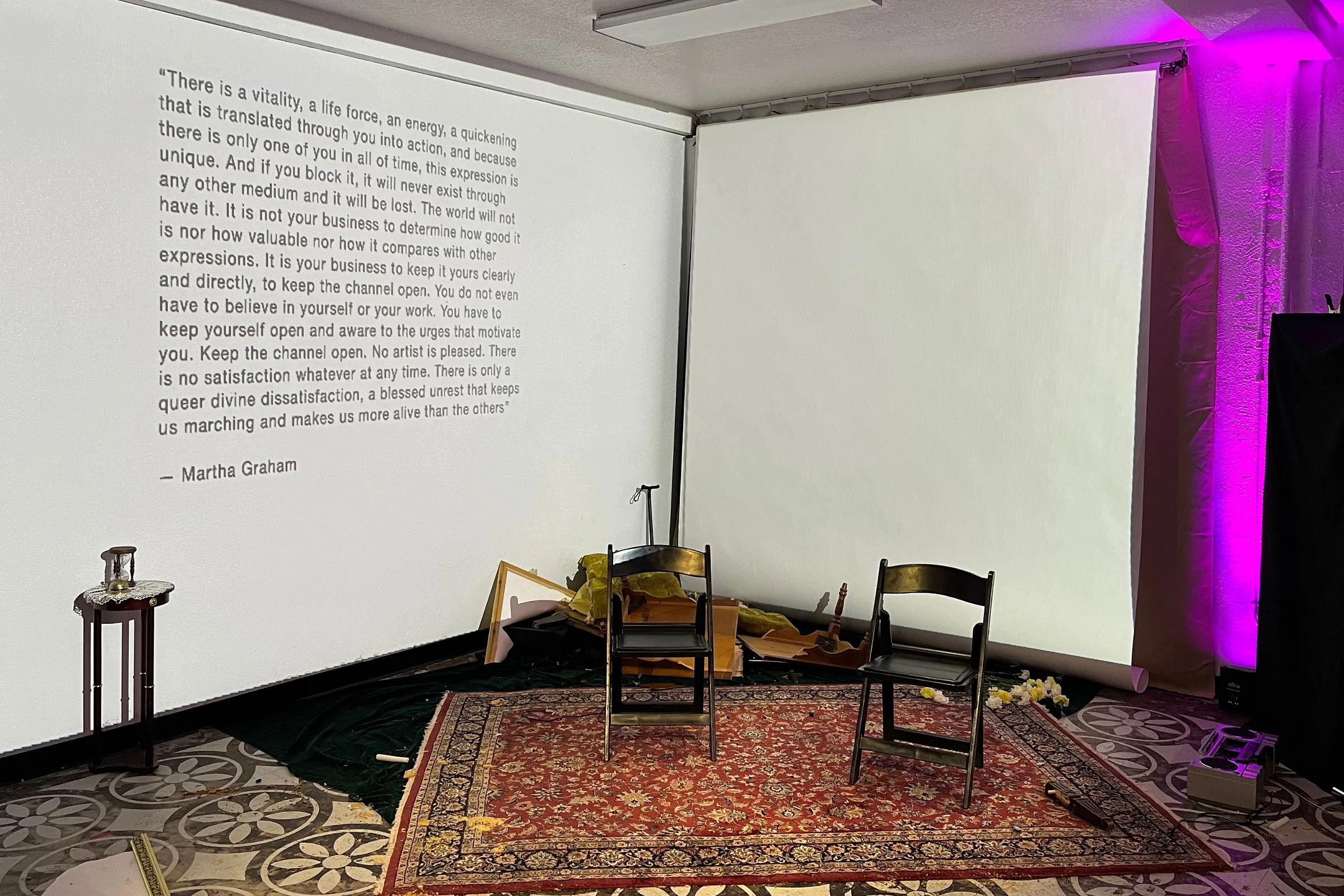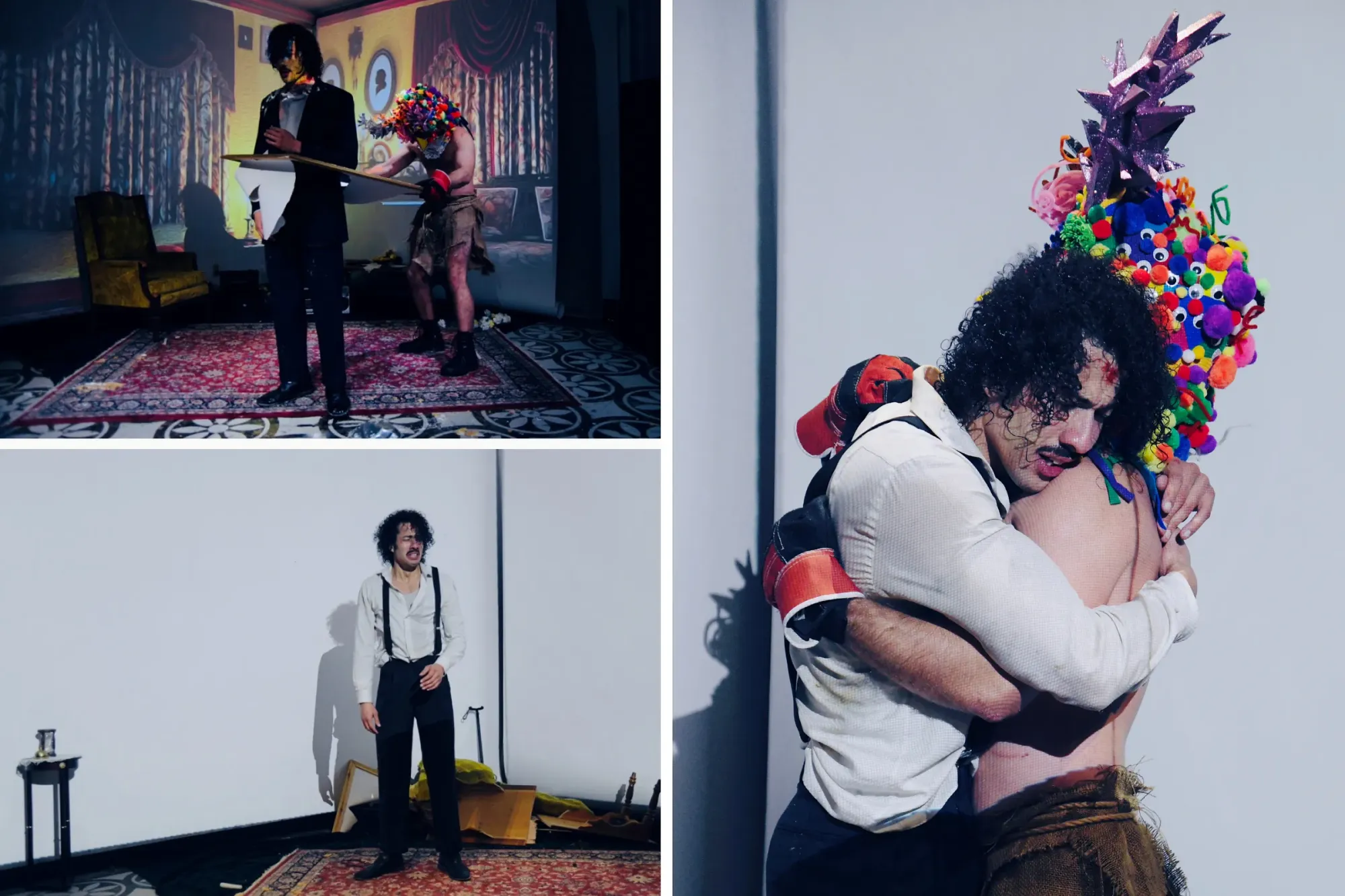Trueson Daugherty: “Disruptive Force”
Logan Miller Studio
Tulsa
Nov. 25, 2023
Any time someone gets onstage or puts a brush to canvas, they’re pouring out their life force for everyone to see. In Trueson Daugherty’s Disruptive Force—presented to a standing-room-only crowd of Tulsa creatives at a photography studio at Admiral and Harvard last weekend — that metaphor took flesh and literal blood in a piece of performance art that I suspect will go down as one of those events that galvanize the people who experienced it for years to come.
Daugherty is a painter whose work has always seemed like it wanted to escape the confines of two dimensions; it’s exciting to see him move further into the realm of performance art.
In this taut and potent new piece, his driving question concerned the creative impulse itself: that unruly, loyal, headstrong, vital “other,” that Fool who lives inside every artist, and whom artists (and their loved ones, and society itself) must figure out how to deal with if they’re going to live with integrity — or really live at all.
Daugherty’s opening image got right to the heart of things. In a suit and tie, he walked into the space with someone very “other” indeed in tow: the creative force itself, performed with genuine bravery by actor Jasper Hammer, wearing a burlap loincloth and a fantastical headdress crammed with pom poms, googly eyes, and glitter antlers.
Against a backdrop of projections of his own home’s elegant walls, Daugherty paced the room, reciting a quote by choreographer Martha Graham that’s saved to the screenshots of many an artist I know: “There is a vitality, a life force, an energy, a quickening that is translated through you into action, and because there is only one of you in all time, this expression is unique. And if you block it, it will never exist through any other medium and it will be lost.”
There’s more to the quote, and Daugherty repeated the whole of it again and again, like a mantra, exhorting the audience to be true to that vitality with the sober urgency of an inspirational speaker giving a TED Talk.
But there’s the exhortation to trust that force, and then there’s the reality of experiencing it.
As the artist insistently proclaimed the necessity of “keep[ing] the channel open,” the non-speaking Force (as I’ll call it) just as insistently reached for and failed to get his attention — first delicately (offering flowers, a tap on the shoulder), then with slapstick japes (water over the artist’s head, pie in his face, boombox playing Rhapsody in Blue turned up to 11, a smashed guitar), and finally with actual violence, which built underneath the repetition of that quote until the artist (still reciting, now shouting/sobbing the lines) was being thrown through a table, shoved and knocked down, taking real blows.
Both performers have a background in practices like wrestling and martial arts; these interactions, like every moment of the piece, were carefully choreographed. (No less challenging for that, they said after the show, both physically and emotionally.) Shifts in the projections, executed by lighting wizard Logan Sours — including, at one point, a blue screen that said “NO SIGNAL” — added another layer of meaning and tension to this “disrupted” world.

The creative force — part toddler, part divinity, who can kind of unintentionally wreck a life while trying to save it, who tantrums but really longs for connection — won’t stay a servant, and it’s a pretty nonfunctional master. Can it be a companion? We can’t live without it; can we live with it? Who’s the real disruptor here?
As Disruptive Force concluded, the artist ventured into that vulnerable unknown. Bloodied and dripping, clothing torn, Daugherty traded the impersonal “you” in Graham’s quote for a first-person “me” and finally faced the Force that had gotten his attention only by almost killing him. They embraced (here I wished for just a bit more exploration of this exhilarating but precarious transition to acceptance). And they walked off together the way they’d come in, leaving the detritus of a manageable but self-exiling life behind them.
I’m still sitting with the questions this piece raised. That’s a gift: it’s not a tidy, wrapped-up harvest, but a seed firmly planted.
I’m also still sitting with some amazing questions from the Q&A—Why didn’t the artist fight back? If you could take a pill that would remove the Disruptive Force from your life, as well as your memory of it, would you? What does not blocking this force look like day to day?—which Daugherty and Hammer addressed with real sincerity.
I could write a whole other story about the warm and deeply engaged crowd at this event, which opened with comments from Karl Jones and continued with striking open mic offerings by Johnny Murrell, Paula Williams, and Josiah Parks. If you’ve never been to one of Daugherty’s Parlour salon experiences, keep an eye out for the next one, especially if you’re an artist yourself.
Thoughtful but accessible, earnest and personal but not self-indulgent, Disruptive Force succeeded with a rigorous conceptual narrative, a skillful use of materials, and committed performances: strong tools that made strong feelings legible and universal. Daugherty’s showing another performance piece this week in Miami, and all of us will be better off if he continues in this medium. Honest, courageous work like this empowers us to encounter challenging realities in a supported way — so we can go home and, just maybe, step a little closer to the risk of meeting our own vitality.
Next for Alicia: “November Grass” by Darren Dirksen at Joseph Gierek Fine Art






